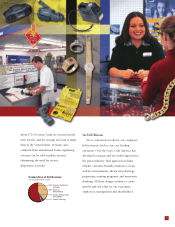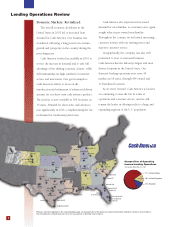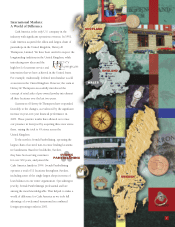Cash America 2001 Annual Report Download - page 18
Download and view the complete annual report
Please find page 18 of the 2001 Cash America annual report below. You can navigate through the pages in the report by either clicking on the pages listed below, or by using the keyword search tool below to find specific information within the annual report.
Interest Rate Risk. Management’s objective is to minimize the cost of borrow-
ing through an optimal mix of fixed and floating rate debt. Derivative financial
instruments, such as interest rate cap agreements, are used for the purpose of
managing fluctuating interest rate exposures that exist from ongoing business
operations. After considering the effectiveness, if any, of the interest rate cap
agreements, the Company had net variable rate borrowings outstanding of
$112.6 million and $71.4 million at December 31, 2001 and 2000, respectively.
If LIBOR were to increase 100 basis points over the rates at December 31, 2001
and 2000, respectively, and the variable rate borrowings outstanding remained
constant, the Company’s interest expense would increase by $1.1 million and $.9
million, and net income after taxes would decrease by $.7 million and $.6 mil-
lion in 2001 and 2000, respectively. If LIBOR were to decrease 100 basis points
from the rates at December 31, 2001 and 2000, respectively, the combined fair
values of the Company’s outstanding fixed rate plus capped rate debt ($62.3 mil-
lion and $99.2 million, respectively) would increase by $1.8 million and $2.1
million as of December 31, 2001 and 2000, respectively.
Foreign Exchange Risk. The Company is subject to the risk of unexpected
changes in foreign currency exchange rates by virtue of its operations in the
United Kingdom and Sweden. Foreign assets, liabilities, and earnings are trans-
lated into U.S. dollars for consolidation into the Company’s financial statements.
As a result of fluctuations in foreign currency exchange rates, the Company has
recorded cumulative other comprehensive losses of $10.8 million and $8.5 mil-
lion at December 31, 2001 and 2000, respectively. A hypothetical 10% decline
in the exchange rates of the British pound sterling and the Swedish kronor at
December 31, 2001 and 2000, would have resulted in additional other compre-
hensive losses of $5.7 million and $5.5 million, respectively.
Net income from foreign operations during 2001, 2000 and 1999 translated
to $5.4 million, $4.9 million and $7.5 million, respectively. A hypothetical 10%
decline in the weighted average exchange rates for each of the foreign currencies
during the years ended December 31, 2001 and 2000, would have decreased net
income after taxes by $.5 million in each year.
At this time, the Company does not use derivative instruments to manage
exchange rate risk of net investments in or earnings of its foreign operations.
From time-to-time the Company transfers funds between currencies and may
concurrently enter into short-term currency swaps to eliminate the risk of curren-
cy fluctuations. No foreign currency swaps were outstanding at December 31,
2001 or 2000.
Gold Price Risk. The Company periodically uses forward sale contracts with
a major bullion bank to sell a portion of the expected amount of fine gold pro-
duced in the normal course of business from its liquidation of forfeited gold mer-
chandise. A significant decrease in the price of gold would result in a reduction
of proceeds from the disposition of scrap jewelry to the extent that amounts sold
were in excess of the amount of future sales. In addition, a significant and sus-
tained decline in the price of gold would negatively impact the value of goods
pledged as collateral by customers and identified as scrap jewelry by the
Company. In this instance, most customers would be willing to add additional
items of value to their pledge in order to obtain the desired loan amount.
However, those customers unable or unwilling to provide additional collateral
would receive lower loan amounts, possibly resulting in a lower balance of pawn
loans outstanding for the Company.
RECENT ACCOUNTING PRONOUNCEMENTS
See discussion in Note 2 of Notes to Consolidated Financial Statements.
CAUTIONARY STATEMENT REGARDING
RISKS AND UNCERTAINTIES THAT MAY
AFFECT FUTURE RESULTS
This Annual Report to Shareholders, including management’s discussion and
analysis, contains statements that are forward-looking, as that term is defined by
the Private Securities Litigation Reform Act of 1995 or by the Securities and
Exchange Commission in its rules. The Company intends that all forward-look-
ing statements be subject to the safe harbors created by these laws and rules.
When used in this Annual Report to Shareholders, the words “believes,” “esti-
mates,” “plans,” “expects,” “anticipates” and similar expressions as they relate to
the Company or its management are intended to identify forward-looking state-
ments. All forward-looking statements are based on current expectations regard-
ing important risk factors. These risks and uncertainties are beyond the ability of
the Company to control, and, in many cases, the Company cannot predict all of
the risks and uncertainties that could cause its actual results to differ materially
from those expressed in the forward-looking statements. Accordingly, actual
results may differ materially from those expressed in the forward-looking state-
ments, and the making of such statements should not be regarded as a represen-
tation by the Company or any other person that the results expressed in the
statements will be achieved. Important risk factors include, but are not limited
to, the following: changes in demand for the Company’s services, changes in
competition, the ability of the Company to open new operating units in accor-
dance with its plans, economic conditions, real estate market fluctuations, inter-
est rate fluctuations, changes in the capital markets, changes in tax and other
laws and governmental rules and regulations applicable to the Company’s busi-
ness, and other risks indicated in the Company’s filings with the Securities and
Exchange Commission.
Management’s Discussion and Analysis of Results of Operations and Financial Condition
16
























